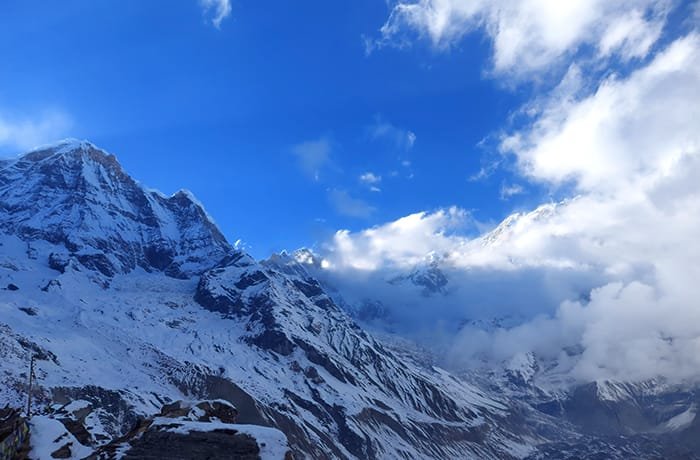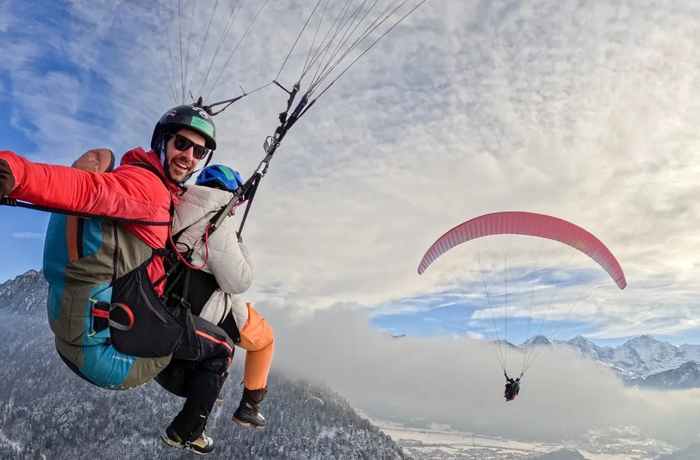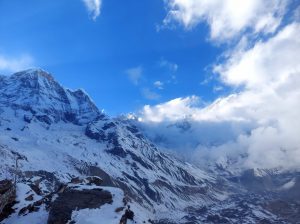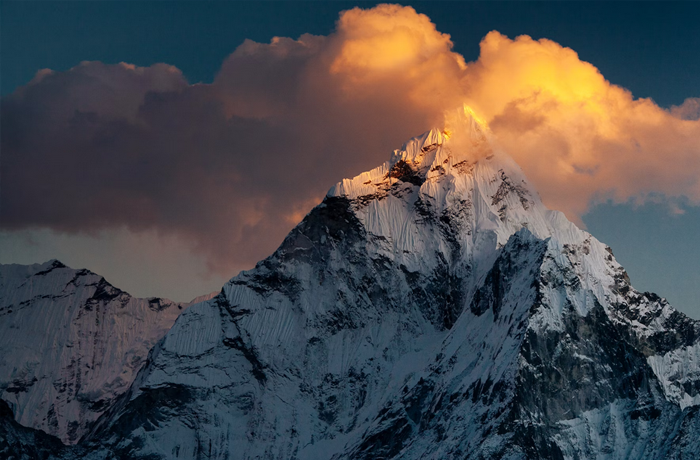Discover the Magic of Annapurna Circuit Trek in 2025

You should put the Annapurna Circuit Trek in 2025 on your bucket list if you’re looking for adventure, stunning scenery, and an unforgettable experience. So without further delay, prepare to experience the enchantment of Nepal’s most famous trek by packing your luggage!
There is something for everyone on the Annapurna Circuit Trek, regardless of experience level. This well-known walk is the ideal fusion of breathtaking scenery, cultural diversity, and exhilarating adventure.
The Annapurna Circuit Trek is still one of the most fascinating treks in the world, even after being opened to tourists in 1949. From subtropical jungles, paddy farms, and the deepest river valley in the world to ice flows, the landscape and culture drastically shift along this path.
Before reaching the Manang area, you will travel via picturesque villages including Dharapani, Chame, and Pisang. You will be able to see the mountain’s majesty and get a close-up look at Buddhist customs.
The climb over Thorang La Pass, one of the world’s highest passes at 5,416 meters, is the trekking highlight of the Annapurna Circuit. Numerous mountains are visible, such as the Tilicho Peak, Dhaulagiri, Manaslu, and Annapurna Massif.
The Annapurna Circuit Trek: Why Choose It?
Everyone can find something to enjoy on the Annapurna Circuit trek, which is more than just a trek. The circuit travels across a variety of landscapes and terrains as it circles a large portion of the Nepal Himalayas.
In addition to its natural splendor, the Annapurna Circuit is rich in history and culture. You will engage with friendly locals, discover their culture, and feel their kindness. Ancient Tibetan Buddhist customs are still practiced in the traditional villages you visit.
With its varied topography, steep ascents, and river valleys, the trail is thrilling and fulfilling. The snow leopard and red panda are among the fascinating variety of creatures that can still be found at higher elevations and in isolated areas like the Tsum Valley.
Highlights of the Annapurna Circuit Trek
- An essential destination for both Buddhists and Hindus, Muktinath is the pinnacle of salvation.
- See the Kali Gandaki River’s steep gorge.
- Learn about the mountain people that live in the Himalayan region.
- At 5,410 meters, the Thorong La Pass is both the highest point on this route and Nepal’s highest peak overall.
- Captivating vistas of Annapurna I, Manaslu, and Dhaulagiri I.
- Explore Pokhara, a lake city with lively nightlife and a laid-back vibe.
- At Tatopani, take a dip in the natural hot springs.
Fitness and Training for Annapurna Circuit Trek
You must be physically conditioned for Annapurna Circuit Trek. Walking 6 to 8 hours a day at changing altitudes, one must develop one’s level of endurance.
The majority of your climb, with a long and steep drop for most of your last day, will present a challenging climb. Make sure to practice low-impact cardiovascular and strengthening exercises for your cardiovascular and endurance capacities.
Muscle strength aids in preventing injuries and reduces fatigue. For your bag-carrying, practice your resistive training and your push-ups for yourself. On a positive note, outsource a porter for most of your loads during your trekking trip.
It takes will and determination to climb at high elevations. The most critical aspect of a successful trip is your state of mind. To become mentally strong, go for long stretches with a loaded backpack.
Foods on the Trek for Annapurna Circuit Trek
During the walk, you eat lunch on the route and breakfast and supper in the teahouses (trekking lodges) where you stay. The Annapurna area offers everything from short hikes to lengthy trekking expeditions.
You should consume high-calorie food to make up for the energy you lose from walking, especially because you will be traveling the path for five to seven hours each day. Foods high in carbohydrates are a great source of energy during trekking.
You can get Nepali cuisine all along the trekking trail. Dal Bhat is a traditional and essential Nepali dish that is made with steamed rice, vegetables (tarkari), pickles (achar), and lentil soup (dal).
Breakfast items in Annapurna Circuit Trek area:
- Tibetan Bread: Usually topped with peanut butter, jam, or honey, it’s a deep-fried flatbread that can also have cheese and eggs added.
- Egg dishes: For a protein boost, try scrambled, boiled, omelets, or fried eggs.
- Paratha: An Indian flatbread filled with potatoes, eggs, or other vegetables, paratha is usually eaten for breakfast.
- Porridge
- Pancakes: Pancakes come in plain, chocolate, and banana variants, and they are all served with peanut butter or honey on top.
- Dishes with noodles
- Coffee or tea
- Cereals: If you’re sick of eating Tibetan bread and pancakes every day, here is a healthy alternative.
Lunch and Dinner items in Annapurna Circuit Trek area:
You stop at a tea shop along the way for lunch amid the trek. Lunch breaks usually last an hour or two. Lunch can be purchased for $4 to $10, depending on altitude and availability.
- Sherpa stew: an energizing stew of meat or vegetables that is thick and warm.
- Momo, another popular Nepalese dish that comes in vegetarian and non-vegetarian forms, is just a steamed dumpling.
- Thukpa or Thentuk: Because it’s served hot and warm, it’s the ideal meal for cold weather. Ideal for chilly weather, this filling noodle soup occasionally contains meat and veggies.
- Fried rice: Another popular dish in Nepal is fried rice, which is white rice cooked with various vegetables, eggs, or meat.
- Various types of pasta
- Noodles: Chowmein, a distinctive type of Nepalese noodles, is served at tea shops along the route.
- Rice pudding.
- Pizza, if available: You may find pizza of various kinds at eateries at lower levels.
- Pie made with apples
The dinner and lunch menus are comparable.
Accommodations for Annapurna Circuit Trek
While you will be there for Annapurna Circuit Trek, there are several lodging options along the Annapurna Circuit Trek, ranging from cozy guesthouses to simple teahouses. You are no longer required to sleep in tents unless you so want.
Some are big, multi-story structures, while others are tiny and only hold a few hikers at a time. Simple meals, a comfortable place to sleep, and an opportunity to encounter local friendliness are all provided by these lodgings.
Teahouses
Annapurna Circuit Trek time you will get teahouses provide incredibly low rates for lodging. Along the Annapurna Circuit, these are the most typical and conventional types of lodging. The majority of teahouses want to profit from food sales rather than lodging.
Usually simple yet cozy, the rooms include cushions, blankets, and twin beds. The atmosphere is pleasant, and the teahouse owners are kind and inviting. Additionally, tea rooms include communal spaces where hikers may unwind, interact, and eat.
Basic amenities like hot baths (often at an extra cost) and electrical device charging stations are also offered by tea houses. In the lower areas, there are teahouses with flush toilets in the western manner. However, the restrooms at teahouses aren’t always the nicest.
Guesthouses
Annapurna Circuit Trek time you will fine more cozy lodges and guesthouses may be found in bigger cities and villages. In terms of the amenities and services provided, guesthouses and tea houses are comparable. The majority of the rooms have WiFi, and they are rather pleasant. The selection on the menu is comparable to that of tea shops.
But at the busiest times of the year, you must reserve your lodging in advance. Trekkers may have to spend the night in the dining hall during the busiest trekking season since there aren’t enough accommodations available.
Best time for Annapurna Circuit Trek
Trekking the Annapurna Circuit is possible throughout the year. However, choosing the ideal season is crucial to making the most of your journey. Selecting the ideal season not only improves your enjoyment but also makes it much easier to finish the walk.
Spring (March to May)
Spring is one of the most exquisite and lovely seasons of the year. A symphony of colors resembles a living painting when trekking the Annapurna circuit in the spring. There is not much mud or snow on the well-kept, smooth route.
The trekking pathways will be lined with rhododendrons and other wildflowers to greet you. Due to the pleasant weather and little to no rain, between 25 and 30 percent of people travel during this period.
Clear skies provide an ideal, unhindered view of the majestic Annapurna and Dhaulagiri mountain ranges. Daytime temperatures in the Annapurna area range from 15°C to 22°C, while nighttime lows can reach -5°C.
Monsoon (June to August)
Heavy rainfall occurs during the monsoon season, particularly in the lower and mid-altitude regions. The shoulder season is another name for this time of year since fewer people hike the Annapurna Circuit during the monsoon.
The pathways are muddy and slick because of the rain that falls nonstop throughout the rainy season. In addition, during the rainy season, leeches infest the Annapurna Circuit route.
Since this is the slowest hiking season, you will not see many hikers. The route experiences temperatures ranging from -3 degrees Celsius at higher elevations to up to 25 degrees Celsius at lower elevations during these months.
Autumn Season (September to November)
The autumn/fall season is the ideal time of year to take in the Annapurna Circuit’s magnificent sights. The terrain is nice and dry, making hiking simple. Trekkers come to the Annapurna region during this time to walk popular routes, such as the Annapurna Circuit Trek.
Additionally, the weather is ideal, with a tinge of crispiness and coolness that signals the arrival of winter. There is less likelihood of rain during the autumn because there is less precipitation, and the hiking paths are often dry.
It’s a beautiful time of year to see the stars since the trails aren’t dusty and the evenings are clear. The Annapurna Circuit is the ideal place for hiking because of its ideal autumnal temperatures, which vary from 4 to 20 degrees Celsius.
Winter season (December – February)
The Himalayas have their coldest season during winter when there are frequent blizzards and significant snowfalls. The Annapurna circuit becomes a winter bliss during this time of year, which is quite divine.
Major passes and higher areas like the Upper Mustang and Thorong La passes may also be closed as a result of the cold and snow. Since there are fewer trekkers in the winter, you’ll have a more tranquil experience with fewer people.
The difficulties accompany the beauty since the snow also makes the route extremely slick, making it dangerous. There is a higher risk of frostbites due to the extremely low temperatures, which range from 5 to 10 degrees Celsius during the day and -10 to -15 degrees Celsius at night.
Permits for Annapurna Circuit Trek
The Annapurna Circuit trek requires much planning. Getting trekking permits for the Annapurna circuit is one of them. The Annapurna Conservation Area Permit (ACAP) and the Trekkers Information Management System (TIMS) card are the two permits you require.
Annapurna Conservation Area Permit (ACAP):
The Annapurna Conservation Area, through which the journey goes, requires this permission to access. It is carried out by the Annapurna Conservation Area to preserve and advance the Annapurna protected area.
You may get ACAP from two Nepali government agencies. The Nepal Tourism Board (NTB) is the first. ACAP can also be provided by the Nepal Trust for Nature Conservation, another government agency.
Thus, getting the permission in Pokhara or Kathmandu is more practical. To get your permits for the Annapurna circuit trip, you will need to apply. It costs 1000 Nepali rupees per person for trekkers from SAARC countries and 3000 Nepali rupees per person for visitors from other countries.
Trekkers Information Management System (TIMS)
For the sake of their safety and simple rescue in the event of an emergency, every hiker on the path must have a TIMS card. There are two types of TIMS permits: one for a group trip and one for a solo hike.
This permit is available at the Nepal Tourism Board office or the Trekking Agencies Association of Nepal (TAAN) office in Pokhara or Kathmandu. Anyone who attempts to go on the trek without a TIMS card may be charged with a crime.
Foreigners must pay NPR 2000 for a TIMS card, whereas SAARC citizens must pay NPR 1000.
Annapurna Circuit Trek Difficulty
The Annapurna Circuit Trek is one of the most well-known and well-liked, and for good reason—it’s an experience with a variety of scenery. Trekkers with a reasonable degree of fitness can tackle the moderate-to-difficult Annapurna Circuit Trek.
Trekkers must trek for five to six hours every day, covering eight to fifteen km. There are issues with both mental and physical endurance because of the prolonged length. Depending on the speed and itinerary, the traditional Annapurna Circuit Trek takes 12–21 days.
Trekkers need to have steady energy levels and be able to walk for extended periods. It is necessary to have hiking and trekking experience prior to beginning the Annapurna Circuit hike.
Trekkers will encounter significant altitude differences along the Annapurna Circuit Trek, ranging from 800 meters below sea level to a maximum elevation of 5,416 meters at Thorong La Pass.
Trekkers face several severe obstacles due to the high altitude circumstances. Your oxygen levels begin to decline as soon as you reach thin air, causing your body to function with less oxygen.
Altitude sickness is far more likely to occur in these situations, and symptoms including nausea, lightheadedness, appetite loss, and insomnia may manifest. Ignoring these symptoms might make them worse and compel you to descend.
One challenging aspect of the Annapurna Circuit Trek is the terrain. Every terrain has its difficulties, requiring both physical effort and flexibility. Particularly at higher elevations, you will come across rough pathways, suspension bridges, and uneven terrain.
The Annapurna area experiences unpredictable weather patterns that can alter significantly at any time. There can be difficulties throughout the walk due to unexpected snowfall or rain.
Regardless of your level of experience, this trip across the breathtaking Himalayas will create memories that will last a lifetime. From the verdant subtropical woodlands and charming towns to the breathtaking high-altitude passes and majestic peaks, each stage of the journey offers a fresh viewpoint on Nepal’s breathtaking landscape.
Every season has its distinct beauty, whether you prefer the vivid springtime blossoms, the crisp autumn air, or the quiet of winter. This walk is a genuinely life-changing experience because of the amazing mountain views, the rich Buddhist legacy, and the kind villagers.
Depending on your stamina and strength, the journey might be either moderately or extremely arduous. Successful completion of the walk requires adequate preparation, which includes mental toughness training and physical fitness training.
The best time to go on this renowned journey is in 2025 if you’re looking for excitement, personal development and a close bond with the natural world Best Trek and Adventure will assist your life-time memorable trip.










